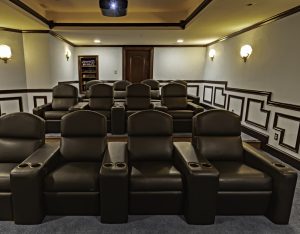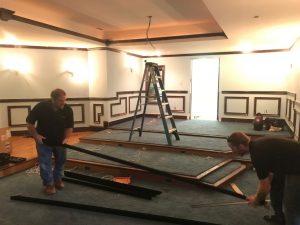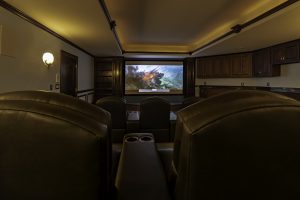Home Theater Seating

Here’s a recent article published by Elite Home Theater Seating:
We recently sat down with Brian Moseley of Moseley Electronics to chat about building custom home theaters. With over 25 years experience working in the industry, we couldn’t think of a better person to kick off our series.
The design we’ve chosen to highlight is a unique home theater that features three rows of custom Elite seating. This project is particularly interesting as it came about as a result of severe water damage. Not that you’d guess, looking at the pictures!
If you’re looking for insider tips, then Brian provides plenty of insights into the factors you need to take into consideration when designing state of the art theater spaces. From general advice around dealing with ambient lighting and sourcing the right custom seating, to the nitty-gritty of finding the right remote system, this is an excellent resource whether you’re an experienced interior designer or a DIY rookie.

Hints & tips for building an amazing custom home theater
1. Can you tell us a little bit about this custom home theater and the scope of the initial project?
It’s a pretty interesting story. Originally, we installed a home theater for this client over ten years ago. Then, a year and a half ago, their home suffered catastrophic water damage. It left their home gutted and the home theater destroyed. The seating, electronics – everything, had to be ripped out and rebuilt from the ground up. Once the space was stripped back to the bare studs, we replaced everything and rebuilt their home theater from scratch. It also offered an opportunity to upgrade a lot of the electronics because quite a few things had changed in ten years.
2. How did you go about upgrading this home theater?
So much has changed in the industry and equipment has come incredibly far in the last ten years, that we upgraded everything. Although they had updated some equipment, we knew that this was the perfect opportunity to bring their theater to the next level. For instance, we installed a Stewart Filmscreen which was an immediate improvement. That quality of image just wasn’t possible ten years ago. We also put in Monitor Audio’s flagship speakers in the walls and ceiling which drastically improved the acoustics. We upgraded them to a new 4k Sony Projector, and of course, the seating was a massive improvement. The original chairs we used were just not on par with what Elite HTS has to offer, and our client agrees — they love the new chairs!
3. Was there anything particularly unique about this project?
Sure! When it comes to building home theaters, you soon realize that every space is different and there are quite a few things that change from project to project. I guess one thing that was in our favour is that this was a rebuild, so we’d already figured out the acoustics and the dimensions didn’t change. Some rooms are just weird when it comes to sound, but this one wasn’t.
We also didn’t have to worry about acoustics and lighting in the same way we usually would. The theater is located in the basement of the home, so there were no ambient lighting issues. That’s usually a major concern when it comes to designing these spaces, and it’s always nice when it’s not an issue. If ambient lighting were present, you would need to take steps to eliminate it — purchasing a film screen with ambient light qualities or taking steps to block any light.
4. Can you speak about the factors you needed to consider when designing this space?
One of the big things with any of these custom projects is considering the client. We’ve worked with him for over ten years, and he’s a well-respected Vietnam War Veteran. I was conscious that we didn’t want just to put the room back together again. I saw it as a chance to do something extraordinary and exceed his expectations. We took steps to ensure he was blown away by the upgrades.
On the URC control side of things, I wanted to enhance the user experience. Controls are often overlooked, and they’re one of the most important parts of making the theater easy to operate. There needs to be remote access so that if there are issues, they don’t need to call a technician out to the house. We can log in from the office and get everything running smoothly again.
As you can see from the pictures, the seating turned out beautifully. The screen, controls, and projector were objectively superior to their predecessors. All our partners stepped up.
5. Were there any restrictions or constraints when it came to designing this home theater?
Not really, the budget wasn’t a concern, and our focus was on quality first. We’ve built up a level of trust with the client over the years, so they were happy to trust our judgement when it came to choosing the right products. We would make suggestions and then provide samples. With the chairs, we introduced the idea of silk leather, which they loved, and then let them pick the colours and styling that appealed to them.
6. What would you say are the four key elements to get right in a home theater?
That’s easy! The first elements you have to get right are audio and video, without those, it’s not going to cut it. After that, the primary concerns would be the control system and network.
A poorly programmed home theater results in a terrible user experience. The last thing anyone wants is a beautiful room where it’s a struggle to play a movie or turn on the system.
Part of ensuring that everything works smoothly is to put a strong network in place. I think of the network as the backbone of your home theater, without it you can’t do simple things like stream movies!
In this theater, we used the Luxul network, it gives us the ability to manage the system remotely if anything goes wrong! So far, there have been no issues, but technology is what it is. Our client can rest assured that if there ever is an issue, we can log in and manage it from our office.
7. If someone was to ask you for advice on designing a home theater, what would you say?
Contact a professional! I honestly believe they need to find someone in the CEDIA professional network and not just someone working out of their garage. At least get a consultation on your space before you get started so that you get a real feel for the scope of the project. We give free estimates as part of our services, but I can’t stress enough, how important it is to get people with the experience and knowledge to do things properly.
You want to use an established business too. There’s no point hiring someone who will have disappeared in two or three years when you might need them to fix something. Pay attention to the certifications and experience of the people you hire; it matters! Otherwise, you’re going to have to pay to have the mistakes fixed when things don’t run smoothly. 
8. What commonly goes wrong when people DIY their home theaters?
The first thing that always strikes me is how messy the electronics will be in these situations. It’s as if the home theater has been thrown together with very little patience. You cannot DIY a good control system, and products like the popular Logitech system just won’t cut it at this scale.
4K video is also tricky for the uninitiated and can be challenging to deploy. It requires training and skill to get it right. It’s not the sort of task your average end user can handle. Googling “how do I build a home theater” won’t shed much light on the situation either. None of the results will help you with understanding how to build stable connections over longer distances.
9. Can you tell us about the differences between home theater projects?
I don’t like to put customers in boxes. I probably sound like a broken record at this point, but it’s so important to me that each home theater is custom built. You can’t just take three boxes and three price points and then deploy the box they pick. Every space is different, and you need to plan accordingly. You’re going to have a very different solution for someone who has kids, or an empty nester, or even, someone who will have kids in the space occasionally. For example, tower speakers at the front of a room may be a terrible decision if kids are going to be running around in the space. Lifestyle effects design.
Even something as basic as the customer’s physical characteristics will change how I design the space. Making sure everything is easy to access, so they don’t have a hard time using it, is a top priority. I like to make sure customers are involved from the ground up, and we work with them so that they’re involved with all the selections and choices. 
10. Were there any resources/companies that you would recommend when designing home theaters?
I’ve mentioned a few of the home theater specialists we work with already: Stewart Filmscreen, Monitor Audio, Sony, Elite HTS, Luxul network, and, of course, CEDIA. Another company that I’ve worked with for years is Crowson. They specialize in amplifiers and actuators (i.e. the technology that makes your seat rumble when there’s an explosion in the movie and things like that!). Customers love this touch and so, I was delighted when I spoke to Elite and found out they include this technology in their custom theater seating.
11. What would you say is the most important thing to consider when selecting home theater seating?
There are three factors that I think are of equal importance. The chair needs to be comfortable, look beautiful, and be a quality build. If it’s not comfortable, then it’s not fit for purpose and goes against the whole idea of sinking in (a little, not too much! I always look for a balance of firmness and softness) for the evening and watching your favourite films.
12. Why did you choose Elite HTS chairs?
First, I liked dealing with the people at Elite. I met them at a CEDIA conference and found that they were easy to work with, as well as, providers of an impressive product. The chairs had that wow-factor. I’m also a big fan of the silk leather, which feels amazing to touch. When I got the call for this particular project, I just knew Elite was the right fit.
13. What was the project process with Elite HTS like?
Easy! I had an idea of what would work. Within an hour of contacting them about the project they had sent over all the documentation I needed, they then overnighted me samples. In just a couple of days, I had everything I needed to show the customer. I was able to sit down and let them choose from colour swatches, as well as select the chair designs and material they preferred. We were able to order immediately, as we were given enough information to ensure the clients were completely satisfied with their decisions.
Note: The custom theater seats featured in this project are the N3 Black Onyx Wide Arm with Double Cup Holders.
About Moseley Electonics:
Family owned and operated since it was founded in 1976, Moseley Electronics is a full service electronics systems company that services and installs systems for residents and businesses of central Virginia. Our expert senior technicians each have over 25 years’ experience and we are Class A contractors. We are members of CEDIA, Azione Unlimited, Better Business Bureau, and the Home Building Association of Richmond.
Comments are closed.